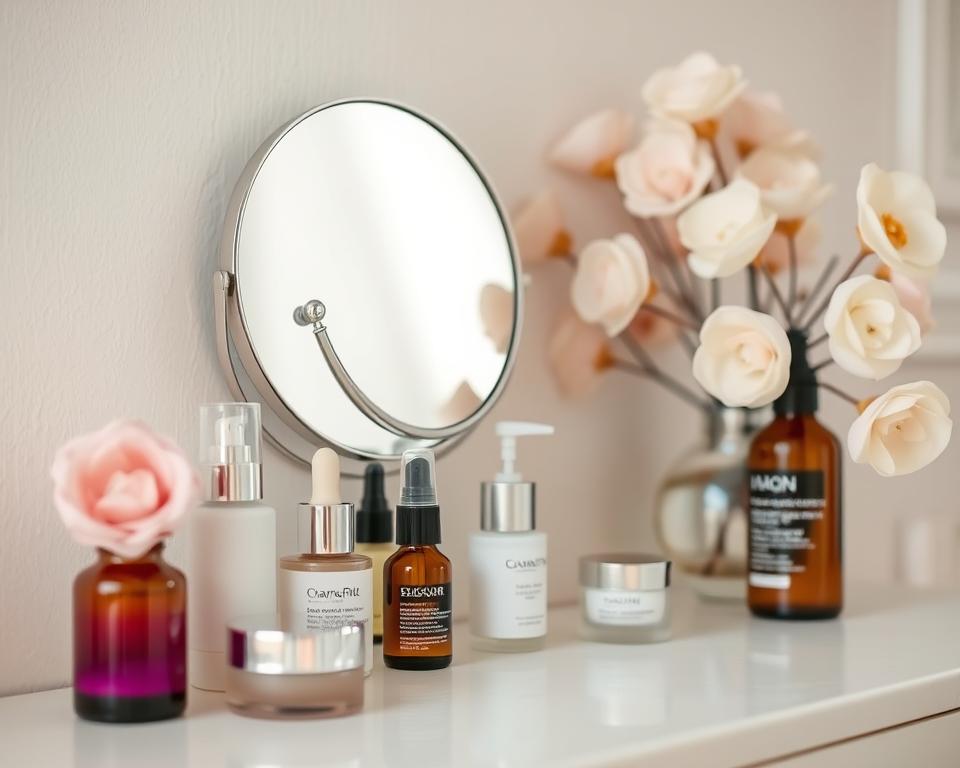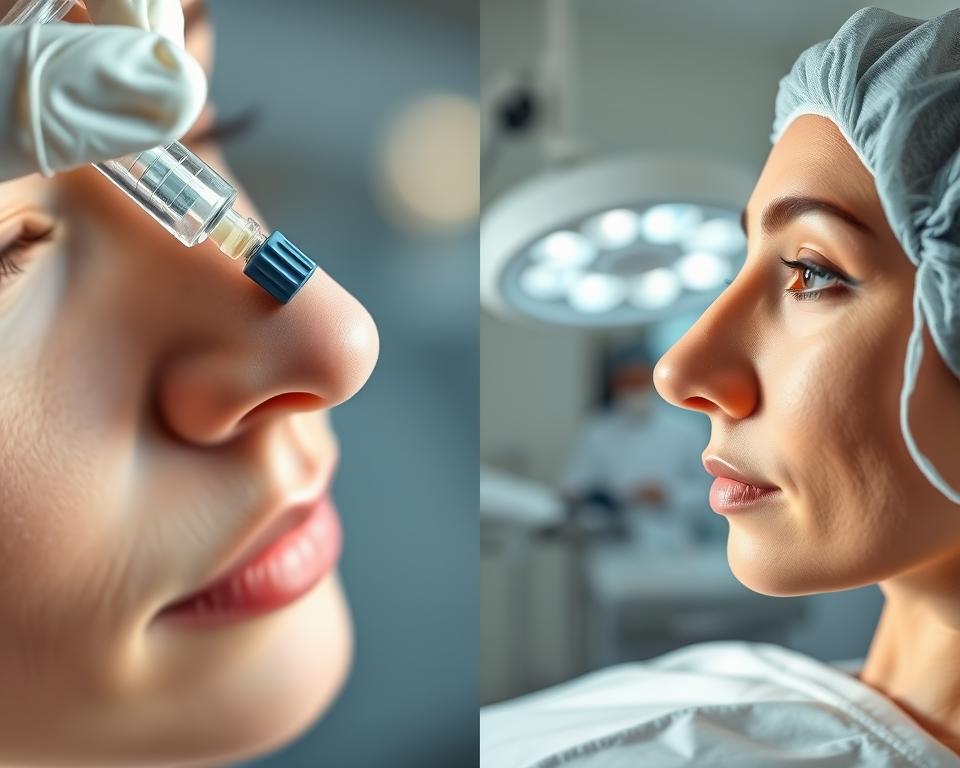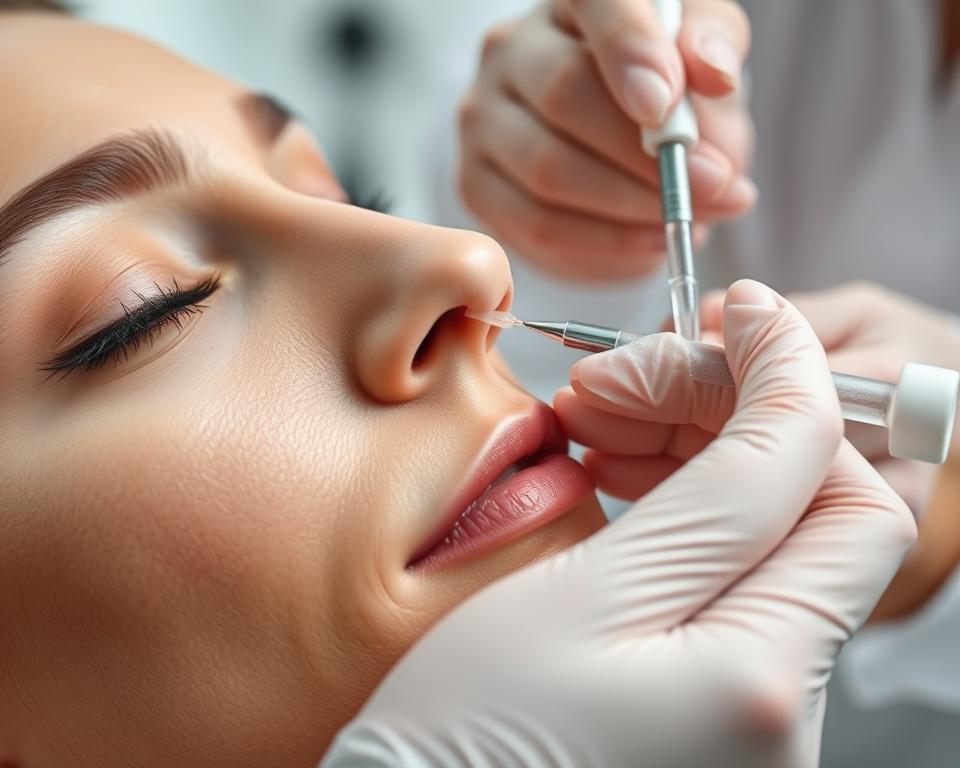In the world of beauty, nose fillers have changed the game. They offer a way to make your nose look better without surgery. This method is temporary, easy to reverse, and doesn’t cut deep into your skin.
People call it a “liquid nose job” or “injectable nose contouring.” It uses fillers injected into your nose to change its shape and size. This way, you can fix your nose’s look without the big risks and long recovery of traditional rhinoplasty.
Read interesting things at : kamilyle
Key Takeaways
- Nose fillers provide a non-surgical alternative to traditional rhinoplasty surgery.
- This innovative approach involves the injection of dermal fillers to reshape and enhance the nose.
- Nose fillers offer a temporary, reversible, and minimally invasive solution for nasal contouring.
- The procedure is designed to refine the appearance of the nose without the extensive downtime and risks of surgical rhinoplasty.
- Nose fillers have gained popularity as a “liquid nose job” or “injectable nose contouring” solution.
What are Nose Fillers?
Nose fillers, also known as dermal fillers or liquid nose jobs, are a non-surgical way to change the nose’s look. They don’t need the surgery of traditional rhinoplasty. By injecting fillers into the nose, experts can fix various cosmetic issues. This includes smoothing bumps or changing the nose’s shape and size.
Understanding the Non-Surgical Solution
Using nose fillers is a quick procedure that takes just a few minutes. It’s less invasive than surgery, which means no general anesthesia or long recovery. This method is popular because it’s easy, has little downtime, and gives natural-looking results.
Types of Dermal Fillers Used for Nose Reshaping
For reshaping the nose, hyaluronic acid and calcium hydroxylapatite fillers are commonly used. Hyaluronic acid fillers, like Restylane and Juvederm, are soft and can be shaped or removed if needed. Calcium hydroxylapatite fillers, such as Radiesse, are firmer and great for adding volume or definition. The filler type depends on what you want and your face’s shape.
“Nose fillers offer a non-surgical solution for those seeking to enhance the appearance of their nose without the recovery time and potential risks associated with traditional rhinoplasty.”
Benefits of Non-Surgical Nose Reshaping
Nose fillers, also known as non-surgical rhinoplasty or injectable nose contouring, have many benefits over traditional surgery. They are a quick and easy way to make small changes to your nose. These changes are also temporary, so you can try them out without a long-term commitment.
One big plus of nose fillers is how fast they work. You can get the treatment done in one visit, usually in under an hour. This means you can get back to your day without much delay. Traditional surgery takes several hours and a long time to recover from.
Another great thing about non-surgical nose reshaping is that you can reverse it if you don’t like the results. The fillers can be dissolved, taking you back to how you looked before. This is perfect for those who are unsure about making permanent changes to their face.
Fillers can also make your nose look more natural and in line with the rest of your face. By carefully placing the fillers, experts can fix things like bumps or a droopy tip. They do this without making your whole face look different.
| Benefit | Description |
|---|---|
| Faster Treatment | Nose fillers can be completed in a single office visit, typically in less than an hour. |
| Reversible Results | The effects of nose fillers are temporary and can be easily dissolved if desired. |
| Natural-Looking Enhancements | Skilled providers can subtly refine the nose without drastically altering the overall facial appearance. |
Non-surgical nose reshaping is a great choice for those wanting a quick, safe way to improve their nose’s look. It’s faster, more flexible, and can make your nose look more natural. This is why many people are choosing fillers over traditional surgery.
Candidates for Nose Fillers
Not everyone is a good fit for nose fillers. It’s important to look at a person’s physical traits and health history. This helps make sure the treatment works well. We’ll talk about who can get nose fillers and who might not be a good candidate.
Ideal Candidates for the Procedure
People with small, minor flaws in their nose are usually good candidates for fillers. This includes a slightly crooked or uneven nose, a bump on the bridge, or wanting more volume or definition. Those who have realistic hopes and understand the temporary nature of the results work best with nose fillers.
Contraindications and Precautions
Nose fillers aren’t right for everyone. They’re not good for those with big nasal problems, like a severely crooked septum or a nose that looks out of place on the face. People with a history of keloid scars, autoimmune diseases, or skin infections near the nose should think twice. It’s important to talk to a qualified doctor to see if nose fillers are a good idea.
| Ideal Candidates | Contraindications |
|---|---|
|
|
Knowing who’s a good fit and who isn’t for nose fillers helps people make smart choices. Talking to an experienced doctor is key to seeing if this treatment meets your needs and goals.
Preparing for Nose Filler Treatment
Before getting ready for preparing for nose filler treatment, it’s key to prepare well. This means following a few important steps for a safe and good result.
First, set up a meeting with a skilled and experienced expert. In this first talk, the expert will look at what you want to achieve, your health history, and any issues that might be a problem. They will also explain the treatment, what you can expect, and any risks or side effects.
- Review medical history and disclose any existing conditions
- Discuss expectations and desired outcomes with the provider
- Understand the treatment process and potential risks
- Follow any pre-treatment instructions provided by the provider
You might be told to skip some medicines or supplements that could make bleeding or bruising worse, like blood thinners, aspirin, or ibuprofen. The expert might suggest using creams to numb the area or ice packs to lessen discomfort during the treatment.
“Proper preparation is key to a successful nose filler treatment. By working closely with a qualified provider and following their instructions, patients can feel confident and comfortable throughout the entire process.”
By getting ready for nose filler treatment the right way, you can make sure it goes smoothly and well. This way, you can reach your beauty goals.
The Nose Filler Procedure
Thinking about getting a nose filler procedure? It’s key to know what happens step by step. First, you’ll talk with a healthcare provider to set your goals and plan your treatment.
Step-by-Step Process
The nose filler procedure is usually fast and easy. At the start, the area gets cleaned and numbed with a cream. Then, the filler is injected into the nose with care to shape it right.
- Cleansing and Numbing the Treatment Area
- Injecting the Dermal Filler
- Massaging and Shaping the Nose
- Evaluating the Results
Anesthesia and Pain Management
To make sure you’re comfortable during the nose filler procedure, doctors use anesthesia and pain management methods. This might be a numbing cream, local anesthesia, or both. You’ll likely feel little to no pain, making the whole process easy.
“The key to a successful nose filler procedure is the provider’s expertise and attention to detail. They must have a deep understanding of facial anatomy and the art of subtle, natural-looking enhancements.”
Knowing the step-by-step process and anesthesia and pain management helps you feel ready and informed. This way, you can start your non-surgical nose reshaping with confidence.
Recovery and Aftercare
Getting a nose filler is a big step to improve your look. But, it’s not the end of your journey. Taking good care of yourself after the treatment is key for the best results and quick recovery. We’ll talk about what happens after the procedure and what care you should follow.
What to Expect After Nose Filler Treatment
Right after the treatment, you might see some minor side effects like swelling, redness, and bruising. These are normal and will go away in a few days to a week. As the filler settles and the side effects lessen, your nose will look better.
Your healthcare provider will give you specific aftercare instructions. This might mean avoiding hard work, using cold compresses, and not touching your nose for a bit. Following these steps can lower the chance of problems and make recovery smoother.
Recommended Aftercare
Here are some tips for a good nose filler aftercare:
- Avoid wearing eyeglasses or sunglasses for the first few days to prevent any unnecessary pressure on the treated area.
- Refrain from strenuous exercise or activities that may increase blood flow to the nose for the first 24-48 hours.
- Apply a cold compress to the treated area for the first few days to help reduce swelling and discomfort.
- Gently clean the treated area with a mild cleanser and avoid rubbing or massaging the nose.
- Follow any specific instructions provided by the healthcare provider, such as the use of topical ointments or medications.
By following these nose filler aftercare tips, you can make sure your recovery is smooth and successful. This will help you get the look you want.

Potential Risks and Complications
Nose fillers are usually safe and effective. But, there are risks and complications to know about. It’s important to understand these to make a good choice and get a positive result.
One big worry is bruising and swelling. These are common and usually go away in a few days to a week. But, sometimes, swelling can be worse or even block blood flow, which is serious and needs quick medical help.
- Bruising and swelling
- Vascular occlusion
- Infection
- Allergic reaction
- Asymmetry or uneven results
- Difficulty breathing
Other risks include infection, allergic reactions, and uneven results. In rare cases, you might have trouble breathing. Remember, the effects of nose fillers don’t last forever. You might need to have them removed or dissolved later.
| Potential Risk | Likelihood | Severity | Management |
|---|---|---|---|
| Bruising and swelling | Common | Mild to moderate | Ice packs, anti-inflammatory medication |
| Vascular occlusion | Rare | Severe | Immediate medical intervention |
| Infection | Rare | Moderate to severe | Antibiotics, proper wound care |
| Allergic reaction | Rare | Moderate to severe | Antihistamines, corticosteroids |
To avoid risks with nose fillers, pick a skilled and qualified provider. They should carefully check your needs and do the treatment with great care. Regular check-ups and monitoring are key for a safe and good result.
Longevity and Maintenance
Many people wonder, “How long do nose fillers last?” This question is key when thinking about the cost and effectiveness of the treatment. Luckily, nose fillers can last long, making them a good choice for enhancing your look.
Nose Filler Longevity
The life of nose fillers changes with the type used, your metabolism, and the nose area treated. Most fillers last 6 to 12 months before needing more treatment. Some people might see effects last up to 18 months.
Maintenance and Touch-Up Treatments
Keeping nose fillers working well means regular check-ups and touch-ups. These involve small injections to keep the nose looking great. How often you need these depends on you, but many go every 6 to 12 months for best results.
How long fillers last also depends on your lifestyle, skin, and the doctor’s skills. Talking to a skilled doctor is key for the best results and a good care plan.
“The key to maintaining the results of nose fillers is to work closely with a skilled provider and follow their recommended maintenance schedule.”
Knowing how long fillers last and the need for touch-ups helps you make a smart choice. This way, you can plan for the look you want.
Nose Fillers vs. Surgical Rhinoplasty
When looking to improve the nose’s look, people have two main choices: non-surgical fillers and traditional rhinoplasty surgery. It’s key to know the differences to pick the right option for your goals and likes.
Nose fillers are a quick, non-invasive way to make small changes to the nose. They can fix bumps, shape the tip, or even out asymmetries. The process is fast, with little downtime, and you can see results right away. But, these fillers don’t last forever, usually 6 to 24 months, based on the filler type.
On the other hand, surgical rhinoplasty is for those wanting big changes to their nose’s shape and structure. This surgery reshapes the bones and cartilage inside the nose for a bigger change. It gives lasting results but has a longer recovery and more risks than fillers.
| Comparison | Nose Fillers | Surgical Rhinoplasty |
|---|---|---|
| Procedure | Non-surgical, injectable treatment | Surgical reshaping of the nasal structure |
| Reversibility | Temporary, effects last 6-24 months | Permanent, with lasting results |
| Recovery Time | Minimal, with quick return to normal activities | Longer recovery period, with potential for swelling and bruising |
| Risks and Complications | Lower risk of complications, such as infection or allergic reaction | Higher risk of complications, including infection, bleeding, and unsatisfactory results |
| Cost | Generally more affordable than surgical rhinoplasty | Typically more expensive than non-surgical nose fillers |
Choosing between nose fillers and surgical rhinoplasty depends on what you want, your budget, and if you’re okay with a bigger procedure. It’s important to talk to a qualified healthcare professional. They can explain the good and bad of each option to help you make a choice that fits your needs and likes.

Choosing the Right Provider
When looking into nose filler treatment, picking a skilled and experienced provider is key. The success of your treatment depends a lot on the provider’s expertise and care. Keep these points in mind as you look for a provider to make a smart choice.
Credentials and Specialization
Find a provider who is a board-certified dermatologist, plastic surgeon, or another medical expert with training in aesthetic procedures. They should know a lot about facial anatomy and have lots of experience with nose fillers and other injectables.
Track Record of Success
Check out the provider’s before-and-after photos to see their skill and the natural results they get. Ask about their complication rates. Be careful of providers with a history of bad results or complications.
Patient-Centered Approach
A good nose filler provider will listen to what you want and work with you to create a plan just for you. They should be open about the procedure, risks, and what you can expect.
| Credential | Importance |
|---|---|
| Board Certification | Shows the provider has gone through tough training and checks in their area of expertise. |
| Specialization in Facial Aesthetics | Shows the provider knows a lot and has experience with injectables like nose fillers. |
| Positive Patient Reviews | Shows the provider is good with people, pays attention to details, and makes patients happy. |
By doing your homework and picking a trusted, skilled nose filler provider, you can be sure your treatment is safe and will work well. You’ll get the look you want.
Cost of Nose Filler Treatment
When looking into nose filler treatment, cost is a big concern for many. The price can change a lot based on several factors. Knowing the typical costs helps you make a smart choice and plan your budget.
The cost of nose filler treatment depends on several things, such as:
- The specific type of dermal filler used
- The amount of filler needed for the desired look
- The provider’s experience and skill
- The location where you get the treatment
- Any extra fees or charges
Generally, the cost of nose filler treatment is between $600 to $2,000 per syringe of filler. But, the total cost can go up because most people need more than one syringe. Some providers might also charge for a consultation or a facility fee, adding to the cost.
“The key to managing the cost of nose filler treatment is to work closely with a qualified and experienced provider who can help you understand the specific requirements for your individual needs.”
Some health insurance might cover the cost of nose filler treatment if it’s seen as medically needed. But, you should talk to your insurance to see how much they cover and what you might have to pay out-of-pocket.
Nose Fillers: A Temporary Solution
Nose fillers are a non-surgical way to change the look of your nose. But, they don’t last forever. You’ll need to get them done again to keep looking good. It’s important to know this before you decide to get them.
Fillers work by being injected into your nose to make it look better. But, your body breaks them down over time. So, you’ll need to get them done again every 6 to 12 months to keep your nose looking the way you want.
When thinking about nose fillers, be realistic. They can make your nose look better quickly and easily. But, you’ll need to keep coming back for touch-ups. This means you’ll spend money and time to keep your nose looking good.
| Nose Filler Longevity | Average Duration |
|---|---|
| Hyaluronic Acid Fillers | 6-12 months |
| Calcium Hydroxylapatite Fillers | 12-18 months |
| Poly-L-Lactic Acid Fillers | 12-24 months |
Knowing that nose fillers don’t last forever helps you make a smart choice. Talk to a qualified healthcare provider to make sure you understand what’s involved. This way, you can have a good outcome and keep your nose looking great.
Before and After Results
Looking at real-life nose filler results is key to understanding what to expect for your own treatment. This section shows before and after pictures. It highlights the changes possible with nose fillers.
Realistic Expectations
It’s key to have realistic hopes when getting nose fillers. These treatments can look great but aren’t perfect for everyone. The results depend on your nose’s shape, what you want fixed, and the doctor’s skill.
Here are some changes you might see with nose fillers:
- Smoothing out bumps or irregularities on the nose bridge
- Subtle narrowing or reshaping of the nasal tip
- Improved nasal symmetry or balance
- Enhanced definition and contour of the nose
Talking openly with your doctor about what you want and what’s possible is important. This way, you can have a good treatment experience and meet your expectations.
Combining Nose Fillers with Other Treatments
Nose fillers can fix many cosmetic issues on their own. But, some people like to mix it with other treatments for a full facial refresh. This mix is great for those wanting a balanced and youthful look.
Many choose to pair nose fillers with botox or other injectables. This combo tackles wrinkles, fine lines, and lost volume in the face. It makes the face look younger and more in harmony.
Some also add laser resurfacing or chemical peels to the mix. These treatments improve the skin’s look and feel. They help hide any leftover flaws, leaving the skin smooth and glowing.


